Relativity of simultaneity
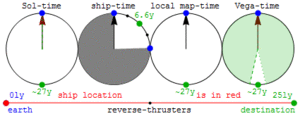
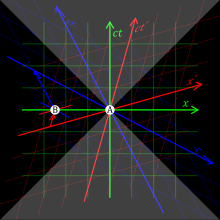

In physics, the relativity of simultaneity is the concept that distant simultaneity – whether two spatially separated events occur at the same time – is not absolute, but depends on the observer's reference frame.
Explanation
According to the special theory of relativity, it is impossible to say in an absolute sense that two distinct events occur at the same time if those events are separated in space. For example, a car crash in London and another in New York, which appear to happen at the same time to an observer on the earth, will appear to have occurred at slightly different times to an observer on an airplane flying between London and New York. The question of whether the events are simultaneous is relative: in the stationary earth reference frame the two accidents may happen at the same time but in other frames (in a different state of motion relative to the events) the crash in London may occur first, and in still other frames the New York crash may occur first. However, if the two events could be causally connected (i.e. the time between event A and event B is greater than the distance between them divided by the speed of light), the order is preserved (i.e., "event A precedes event B") in all frames of reference.
If we imagine one reference frame assigns precisely the same time to two events that are at different points in space, a reference frame that is moving relative to the first will generally assign different times to the two events. This is illustrated in the ladder paradox, a thought experiment which uses the example of a ladder moving at high speed through a garage.
A mathematical form of the relativity of simultaneity ("local time") was introduced by Hendrik Lorentz in 1892, and physically interpreted (to first order in v/c) as the result of a synchronization using light signals by Henri Poincaré in 1900. However, both Lorentz and Poincaré based their conceptions on the aether as a preferred but undetectable frame of reference, and continued to distinguish between "true time" (in the aether) and "apparent" times for moving observers. It was Albert Einstein in 1905 who abandoned the (classical) aether and emphasized the significance of relativity of simultaneity to our understanding of space and time. He deduced the failure of absolute simultaneity from two stated assumptions:
- the principle of relativity – the equivalence of inertial frames, such that the laws of physics apply equally in all inertial coordinate systems;
- the constancy of the speed of light detected in empty space, independent of the relative motion of its source.
The train-and-platform thought experiment

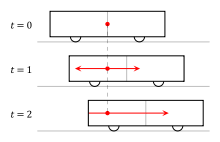
A popular picture for understanding this idea is provided by a thought experiment consisting of one observer midway inside a speeding traincar and another observer standing on a platform as the train moves past. It is similar to thought experiments suggested by Daniel Frost Comstock in 1910[1] and Einstein in 1917.[2][3]
A flash of light is given off at the center of the traincar just as the two observers pass each other. The observer on board the train sees the front and back of the traincar at fixed distances from the source of light and as such, according to this observer, the light will reach the front and back of the traincar at the same time.
The observer standing on the platform, on the other hand, sees the rear of the traincar moving (catching up) toward the point at which the flash was given off and the front of the traincar moving away from it. As the speed of light is finite and the same in all directions for all observers, the light headed for the back of the train will have less distance to cover than the light headed for the front. Thus, the flashes of light will strike the ends of the traincar at different times.


Spacetime diagrams
It may be helpful to visualize this situation using spacetime diagrams. For a given observer, the t-axis is defined to be a point traced out in time by the origin of the spatial coordinate x, and is drawn vertically. The x-axis is defined as the set of all points in space at the time t = 0, and is drawn horizontally. The statement that the speed of light is the same for all observers is represented by drawing a light ray as a 45° line, regardless of the speed of the source relative to the speed of the observer.
In the first diagram, we see the two ends of the train drawn as grey lines. Because the ends of the train are stationary with respect to the observer on the train, these lines are just vertical lines, showing their motion through time but not space. The flash of light is shown as the 45° red lines. We see that the points at which the two light flashes hit the ends of the train are at the same level in the diagram. This means that the events are simultaneous.
In the second diagram, we see the two ends of the train moving to the right, shown by parallel lines. The flash of light is given off at a point exactly halfway between the two ends of the train, and again form two 45° lines, expressing the constancy of the speed of light. In this picture, however, the points at which the light flashes hit the ends of the train are not at the same level; they are not simultaneous.
Lorentz transformation
The relativity of simultaneity can be demonstrated using the Lorentz transformation, which relates the coordinates used by one observer to coordinates used by another in uniform relative motion with respect to the first.
Assume that the first observer uses coordinates labeled t, x, y, and z, while the second observer uses coordinates labeled t', x', y', and z'. Now suppose that the first observer sees the second moving in the x-direction at a velocity v. And suppose that the observers' coordinate axes are parallel and that they have the same origin. Then the Lorentz transformation expresses how the coordinates are related:
where c is the speed of light. If two events happen at the same time in the frame of the first observer, they will have identical values of the t-coordinate. However, if they have different values of the x-coordinate (different positions in the x-direction), we see that they will have different values of the t' coordinate; they will happen at different times in that frame. The term that accounts for the failure of absolute simultaneity is the v x/c2.

The equation t' = constant defines a "line of simultaneity" in the (x', t' ) coordinate system for the second (moving) observer, just as the equation t = constant defines the "line of simultaneity" for the first (stationary) observer in the (x, t) coordinate system. We can see from the above equations for the Lorentz transform that t' is constant if and only if t – v x/c2 = constant. Thus the set of points that make t constant are different from the set of points that makes t' constant. That is, the set of events which are regarded as simultaneous depends on the frame of reference used to make the comparison.
Graphically, this can be represented on a space-time diagram by the fact that a plot of the set of points regarded as simultaneous generates a line which depends on the observer. In the space-time diagram, the dashed line represents a set of points considered to be simultaneous with the origin by an observer moving with a velocity v of one-quarter of the speed of light. The dotted horizontal line represents the set of points regarded as simultaneous with the origin by a stationary observer. This diagram is drawn using the (x, t) coordinates of the stationary observer, and is scaled so that the speed of light is one, i.e., so that a ray of light would be represented by a line with a 45° angle from the x axis. From our previous analysis, given that v = 0.25 and c = 1, the equation of the dashed line of simultaneity is t – 0.25x = 0 and with v = 0, the equation of the dotted line of simultaneity is t = 0.
Accelerated observers
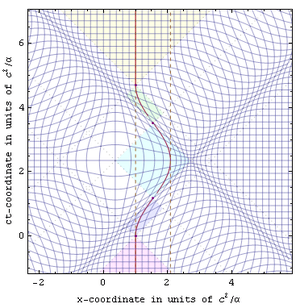
The Lorentz-transform calculation above uses a definition of extended-simultaneity (i.e. of when and where events occur at which you were not present) that might be referred to as the co-moving or "tangent free-float-frame" definition. This definition is naturally extrapolated to events in gravitationally-curved spacetimes, and to accelerated observers, through use of a radar-time/distance definition that (unlike the tangent free-float-frame definition for accelerated frames) assigns a unique time and position to any event.[4]
The radar-time definition of extended-simultaneity further facilitates visualization of the way that acceleration curves spacetime for travelers in the absence of any gravitating objects. This is illustrated in the figure at right, which shows radar time/position isocontours for events in flat spacetime as experienced by a traveler (red trajectory) taking a constant proper-acceleration roundtrip. One caveat of this approach is that the time and place of remote events are not fully defined until light from such an event is able to reach our traveler.
History
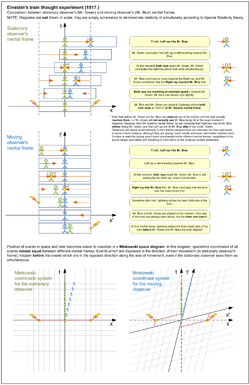
In 1892 and 1895, Hendrik Lorentz used a mathematical method called "local time" t' = t – v x/c2 for explaining the negative aether drift experiments.[5] However, Lorentz gave no physical explanation of this effect. This was done by Henri Poincaré who already emphasized in 1898 the conventional nature of simultaneity and who argued that it is convenient to postulate the constancy of the speed of light in all directions. However, this paper does not contain any discussion of Lorentz's theory or the possible difference in defining simultaneity for observers in different states of motion.[6][7] This was done in 1900, when he derived local time by assuming that the speed of light is invariant within the aether. Due to the "principle of relative motion", moving observers within the aether also assume that they are at rest and that the speed of light is constant in all directions (only to first order in v/c). Therefore, if they synchronize their clocks by using light signals, they will only consider the transit time for the signals, but not their motion in respect to the aether. So the moving clocks are not synchronous and do not indicate the "true" time. Poincaré calculated that this synchronization error corresponds to Lorentz's local time.[8][9] In 1904, Poincaré emphasized the connection between the principle of relativity, "local time", and light speed invariance; however, the reasoning in that paper was presented in a qualitative and conjectural manner.[10][11]
Albert Einstein used a similar method in 1905 to derive the time transformation for all orders in v/c, i.e., the complete Lorentz transformation. Poincaré obtained the full transformation earlier in 1905 but in the papers of that year he did not mention his synchronization procedure. This derivation was completely based on light speed invariance and the relativity principle, so Einstein noted that for the electrodynamics of moving bodies the aether is superfluous. Thus, the separation into "true" and "local" times of Lorentz and Poincaré vanishes – all times are equally valid and therefore the relativity of length and time is a natural consequence.[12][13][14]
In 1908, Hermann Minkowski introduced the concept of a world line of a particle[15] in his model of the cosmos called Minkowski space. The mathematical model of spacetime is an affine geometry equipped with a quadratic form that measures intervals between events. (When the events are connected by light, the interval is zero.) In Minkowski's system, there is a simultaneous hyperplane determined by the quadratic form at each event along a world line. This simultaneous hyperplane depends on the velocity of the particle, and thus is relative to velocity.
Einstein's train thought experiment
Einstein's version of the experiment[3] presumed slightly different conditions, where a train moving past the standing observer is struck by two bolts of lightning simultaneously, but at different positions along the axis of train movement (back and front of the train car). In the inertial frame of the standing observer, there are three events which are spatially dislocated, but simultaneous: event of the standing observer facing the moving observer (i.e., the center of the train), event of lightning striking the front of the train car, and the event of lightning striking the back of the car.
Since the events are placed along the axis of train movement, their time coordinates become projected to different time coordinates in the moving train's inertial frame. Events which occurred at space coordinates in the direction of train movement (in the stationary frame), happen earlier than events at coordinates opposite to the direction of train movement. In the moving train's inertial frame, this means that lightning will strike the front of the train car before two observers align (face each other).
References
| Wikibooks has a book on the topic of: Special relativity |
- ↑ The thought experiment by Comstock described two platforms in relative motion. See: Comstock, D.F. (1910), "The principle of relativity", Science, 31 (803): 767–772, Bibcode:1910Sci....31..767C, doi:10.1126/science.31.803.767, PMID 17758464.
- ↑ Einstein's thought experiment used two light rays starting at both ends of the platform. See: Einstein A. (1917), Relativity: The Special and General Theory, Springer
- 1 2 Einstein, Albert (2009), Relativity - The Special and General Theory, READ BOOKS, pp. 30–33, ISBN 1-4446-3762-2, Chapter IX
- ↑ Carl E. Dolby and Stephen F. Gull (2001) "On radar time and the twin paradox", Amer. J. Phys. 69 (12) 1257-1261 abstract.
- ↑ Lorentz, Hendrik Antoon (1895), Versuch einer Theorie der electrischen und optischen Erscheinungen in bewegten Körpern, Leiden: E.J. Brill
- ↑ Poincaré, Henri (1898–1913), "The Measure of Time", The foundations of science, New York: Science Press, pp. 222–234
- ↑ Galison, Peter (2003), Einstein's Clocks, Poincaré's Maps: Empires of Time, New York: W.W. Norton, ISBN 0-393-32604-7
- ↑ Poincaré, Henri (1900), "La théorie de Lorentz et le principe de réaction", Archives néerlandaises des sciences exactes et naturelles, 5: 252–278. See also the English translation.
- ↑ Darrigol, Olivier (2005), "The Genesis of the theory of relativity" (PDF), Séminaire Poincaré, 1: 1–22, doi:10.1007/3-7643-7436-5_1
- ↑ Poincaré, Henri (1904–1906), "The Principles of Mathematical Physics", Congress of arts and science, universal exposition, St. Louis, 1904, 1, Boston and New York: Houghton, Mifflin and Company, pp. 604–622
- ↑ Holton, Gerald (1988), Thematic Origins of Scientific Thought: Kepler to Einstein, Harvard University Press, ISBN 0-674-87747-0
- ↑ Einstein, Albert (1905), "Zur Elektrodynamik bewegter Körper" (PDF), Annalen der Physik, 322 (10): 891–921, Bibcode:1905AnP...322..891E, doi:10.1002/andp.19053221004. See also: English translation.
- ↑ Miller, Arthur I. (1981), Albert Einstein’s special theory of relativity. Emergence (1905) and early interpretation (1905–1911), Reading: Addison–Wesley, ISBN 0-201-04679-2
- ↑ Pais, Abraham (1982), Subtle is the Lord: The Science and the Life of Albert Einstein, New York: Oxford University Press, ISBN 0-19-520438-7
- ↑ Minkowski, Hermann (1909), "Raum und Zeit", Physikalische Zeitschrift, 10: 75–88
- Various English translations on Wikisource: Space and Time
